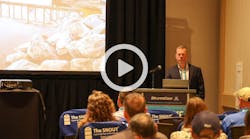Lori Belz spends a great deal of her work time along the highways and other roads of Minnesota, trying to gauge the best approach to erosion control. One of the more interesting research projects in which she has been involved was in bioengineering, trying to stabilize slopes along Minnesota highways that presented an ongoing erosion problem. “I tested wattling, live stakes, and plant plugs and specific native seeding to get a good root structure to hold the slopes soils in place,” says Belz, who is the stormwater management coordinator for the Minnesota Department of Transportation (MnDOT) in the Erosion and Stormwater Management Unit of the Office of Environmental Stewardship. Belz emphasizes that in addition to National Pollutant Discharge Elimination System (NPDES) compliance, “getting a good weedless vegetation establishment is important.” Her work is a key factor for MnDOT, which maintains the state’s 12,000-mile highway system. As with many Midwestern roads that are older than other systems in the country and subject to harsh weather conditions, the state’s roads take a beating, and maintaining good erosion control is critical. MnDOT’s 20-year highway investment plan (2014–2033) will address the challenges of this heavily used system, which comprises just 8.5% of Minnesota’s total roadway miles but accommodates nearly 60% of the miles traveled as well as the majority of the freight. Currently, 50% of the state’s highway pavements and 35% of state highway bridges are more than 50 years old. Minnesota ranks 38 out of 50 in the nation’s interstate pavement condition.
What She Does Day to Day
Belz’s day-to-day responsibilities are to provide guidance for NPDES stormwater pollution prevention plan (SWPPP) compliance, turf establishment, specialty detail support, and special provision support for design and construction. “I also develop standard details, standard plans, and design guidance documents, and provide technical support for making design decisions, plan review, and permit compliance,” says Belz, whose responsibilities have her covering two south districts and a district next to the Canadian border as well as parts of the Twin Cities’ Metro district for construction reviews and technical liaison work. “I also monitor the quality of our certified mulch, sod, and grass seed for MnDOT construction projects in meeting the standard specifications that I wrote so there is good soil seed bed preparation,” she says. Belz provides substitution guidance and field guidance for permit compliance for the Minnesota Pollution Control Agency, the Minnesota Department of Natural Resources, and the US Army Corps of Engineers. “I manage and coordinate the Approved Products List for specification compliance, as well as technical support to help solve unique environmental construction problems, turf establishment concerns, and soil management issues,” says Belz. She also provides technical support for MnDOT maintenance using traditional and nontraditional BMPs for the work, and provides field guidance for meeting NPDES MS4 and construction stormwater permit requirements.
What Led Her to This Line of Work
Belz spent a great part of her childhood playing outdoors at her grandparents’ farm, where she developed an interest in the environment and biology. Belz has taken civil engineering classes at the University of Minnesota and she earned a bachelor of science degree in soil science and biology with an emphasis in conservation from the University of Wisconsin–River Falls. “I happened to be on the job search when the economy was down and the only well-paying job in natural resources was with the government, so here I am today,” notes Belz. “It turned out very well being that there are a lot of opportunities at the DOT. I have worked for the Bureau of Land Management in range management, the Department of Natural Resources in vegetation workforce management, and different offices at the DOT, including maintenance, surveys, final design, and bikeways.
What She Likes Best About Her Work
“I really enjoy the flexibility this job provides,” says Belz. “It is desk work mixed with construction reviews and research work.”
Her Biggest Challenge
“One of my struggles is getting the contractor in construction to take the duties needed to stay in compliance with the NPDES permit seriously,” says Belz. “This would keep our projects in compliance and reduce the inspectors’ workload and struggles.”


